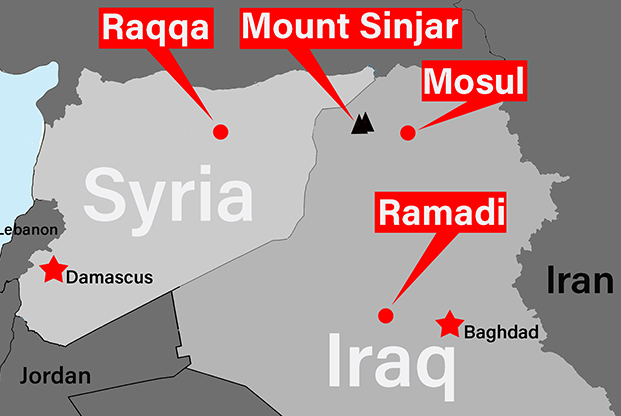
Staff illustration: Mike Tsukamoto
In 2014, ISIS emerged with a roar. It captured vast swathes of Syria and Iraq with stunning speed, and shocked the world with its brutality. It took Raqqa and was on the outskirts of Damascas. In Iraq, it overran Mosul, a city of 2 million people. Abu Bakr al-Baghdadi declared himself the leader of all Muslims and announced the creation of a caliphate.
At its peak, ISIS had 7.7 million people under its sadistic control. Enemies, “infidels,” and those who broke ISIS’ rules were beheaded or stoned. Some were burned alive. Much of this was proudly photographed and videotaped in public. The group destroyed priceless artworks and antiquities deemed inconsistent with ISIS’ view of Islam.
For a brief time, the organization looked unstoppable in Iraq as defense forces fled before ISIS fighters. For Americans, this seemed a disturbing echo of Vietnam.
Iraqi and Syrian defenders were in disarray, and the US response was tepid and ineffective. “Intelligence on ISIS was almost entirely lacking,” Ashton B. Carter, Defense Secretary under President Obama, wrote in The Atlantic last year. ISIS’ capture of Ramadi, Iraq, in May 2015, “with zero warning, three months after I took over the Pentagon, epitomized the problem.”
_
You can read this story in our print issue:
In July 2015, Carter acknowledged, despite spending millions of dollars, the US “had trained and deployed only about 60 dependable anti-ISIS fighters in Syria.”
And then, stalemate. ISIS was stopped 30 miles from Baghdad. Despite inflows of foreign fighters attracted by its ideology and seeming power, ISIS’ gains quickly ended.
The US began building a plan for success. In December 2015, “after months of defensiveness in Washington—about the failed train and equip program, or the pace of the campaign, or our perceived lack of strategy—it was time to go on the offensive,” Carter wrote. Airstrikes ramped up, intelligence platforms were constantly overhead, and US special operators and air controllers embedded with Iraqis and Syrians on the ground. Mosul and Raqqa—ISIS’ capitals and headquarters—were the prime targets, Carter said.
Combined offensives, reliant upon airpower, gradually pushed ISIS back. The battle for Mosul began in October 2016 and lasted nine months, spanning two Presidential administrations. Under Trump, the rules of engagement were loosened, military commanders were given greater autonomy, and the pace of operations further accelerated.
“Every inch of ground the Iraqi Security Forces [ISF] pried from ISIS is testament to their courage in the face of desperate enemy forces who employed suicide bombers, routinely shielded themselves with civilians, and rigged schools and homes with explosives,” wrote Lt. Gen. Jeffrey L. Harrigian, commander of Air Forces Central Command, in December.
When the ISF was “pinned down by fire, coalition air controllers embedded with them called in precision airstrikes to silence the enemy,” wrote Harrigian, who is CENTCOM’s air component commander. “When suicide vehicle bombers raced toward exposed [Iraqis], airpower delivered precision weapons to stop the enemy forces from completing their grisly mission.”
Indigenous forces led on the ground, but success required airpower. As Harrigian noted, “Iraqi allies advanced when our aircraft were overhead, and paused to rest when they were not.”
Beginning with the airdrop in August 2014 that broke the siege of Mount Sinjar, freeing thousands of desperate trapped civilians, the Air Force continually adapted to ISIS’ unique challenges.
In last fall’s battle for Raqqa, A-10 attack jets and remotely piloted aircraft flew in dense urban war zones reminiscent of World War II. Lt. Col. Craig Morash, a deployed A-10 squadron commander, said Warthog pilots “had to get creative to figure out ways to strike targets at the bottom of these five-story buildings.”
MQ-1 and MQ-9 airmen performed “close air support, tactical reconnaissance, and overwatch,” as allies “fought to take back [Raqqa] block by block,” said an unnamed squadron commander in a USAF news release. Raqqa was liberated in October.
In December the Iraqi government declared ISIS defeated.
ISIS’ downfall did not generate nearly the attention its rise did, and even Harrigian’s essay was released on a Friday, three days before Christmas—seemingly timed to avoid notice.
ISIS will continue to be a dispersed terrorist threat and an inspiration to some seeking a radical purpose in their lives. Clean-up operations against ISIS must continue and al-Baghdadi brought to justice.
The entity has lost 98 percent of its territory and has perhaps 1,000 fighters left in Iraq and Syria. But ISIS is dead as a large-scale threat, and airpower killed it. This should not be forgotten.